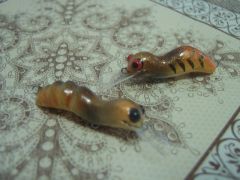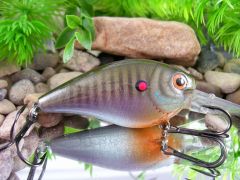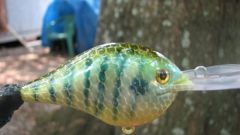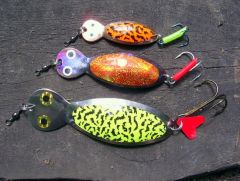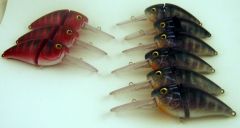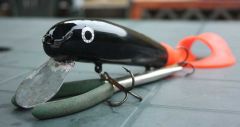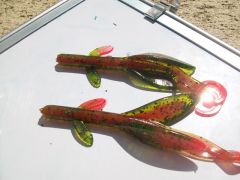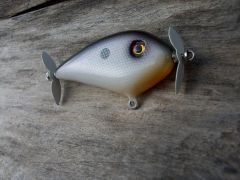-
Posts
14,726 -
Joined
-
Last visited
-
Days Won
364
Content Type
Profiles
Articles
TU Classifieds
Glossary
Website Links
Forums
Gallery
Store
Everything posted by mark poulson
-

some balsa flat lures, 4,6cm and sinking
mark poulson commented on Horsu's gallery image in Hard Baits
-
From what I've read, T shirt paints change molecularly when heated, making them stronger and waterproof. That's why you have to iron the T shirt after you paint it, so the paint doesn't come off when you wash it. Not all acrylic paints are T shirt paints. I spray Createx transparent base over any water based markers, solvent based markers, or off brand manuf. paints that I'm not sure of, and heat set it, before I dip. Be sure to let the lure dry between dips. The urethane is thicker at the bottom, when you hang it to drip dry, and may take a little longer to lose all it's solvent. I hit it lightly with a hair dryer before I dip, and before I re dip. One other thing that can make problems is if you use bondo, and it's not completely set before you paint. It may not show right away, but the bond to the primer will be lost, and, eventually, the whole paint scheme will bubble at that place on the lure. Been there, done that.
-
First of all, you should be able to look at the needle and see if it's bent. If it's bent back in the shaft, you may be able to bend it gently to straighten it. If the very tip is bent, get another needle. But....... It's more likely that your brush is clogged with paint, and your paint needs to be thinned. That's a mistake I made when I first started. If the paint is too thick, or if it has particles that are too large, like some hobby paints, it clogs the tiny holes the paint passes through. There are four tiny holes in the nozzle that can get clogged pretty quickly. Also, you may have paint dried in the outer part of the nozzle itself, and you can clear that by using a soft bristle brush to rotate around where the needle comes out. Be sure to rinse the face afterward. If the brush is clogged, here's what I did and still do. I found that, first off, I needed to soak my brush tip in some acetone, and spray some through the brush, and then back flush with the acetone, to get the clogged paint out. I took out the needle, wiped it down, dipped it into the acetone, and put it back in. I put some more clean acetone in the paint cup, and moved the needle back and forth, using it to clear any paint that was in the passage. Then I pulled the needle back a little, and sprayed acetone through the tip to clear any clogs that got knocked loose. Once you get the brush cleaned, thin your paint with whatever thinner the manuf. recommends. If you use Createx, you can use their airbrush cleaner to thin the paint, or just clean water. But don't over thin it, or it will lose it's film strength. I use some Apple Barrel paints, which are thick, and I thin them with Windex. I try to get the paint to be as thin as skim milk. There are folks here who are a lot better at this than me, and they may have additional advice. Good luck.
-
"T"ing a treble hook means bending the two hooks that rub the belly by holding each in a pair of needle nose, and then bending them out until they are opposite each other. That way, the treble is flat where it rubs the belly, and prevents hook rash. I got that tip here from a walleye troller, who said, before he started doing that, he would wear through a plastic bait pretty quickly. They still stick fish just fine.
-
Clemmy, I found out the hard way that water borne urethanes will make water based sharpies run, too, unless they are sprayed with a heat set clear.
-
BobP, You're exactly right. I found that, if I don't spray a coat of transparent clear Createx over the sharpie and heat set it, the sharpie runs. A couple of time I sprayed too little, and got a kind of "controled" bleeding of the sharpie colors, mostly the red gill blood markings, which looks kind of cool. But I don't do it on purpose.
-
After you've gotten all the paint on and heat set, use a yellow sharpie to draw the stripe down the side. If you use a fine point, double the line to get the width you want. Then spray over that with Createx transparent base and heat set that, to protect the sharpie from the top coat. The same method works for gills, blood lines, and any other fine details you want.
-
Send an email to Steve at steven@stitchware.com He'll get right back to you.
-
-
-
-
-
-
I make only surface gliders, but I've found there's a direct connection between lure length and glide length. The longer the lure, the longer the glide. The shortest glider I make is 5", and it glides about a foot, max., on a slow retrieve. The longest is 9", and it glides 2' if I work it slow. I've made them longer, but they're too hard to throw and workfor any length of time.
-
I hold the jig by the hook over the torch to heat it, then grab the eye with the vise grips and dip, with the vise grips going into the powder first. It's not elegant, but it works. every once in a while, I knock off any powder that's stuck to the vise grips. At first, I tried just dusting the powder over the hot jig, but I got uneven coverage, so I tried it this way. Works for me. You have to kind of play around until you get a system that works for you.
-
Sonny, I just finished painting four surface gliders I made with the white AZEK. I put bondo over the ballast holes, and over the worst spots, sanded them down with 80 grit, and then double dipped them in Minwax Polyacrylic, set sanding with 400 grit between dips. That smoothed out a lot of the surface imperfections. Then I primed them with flat white rattle can primer. I immediately saw a ton of pin holes that the poly didn't fill. After three coats of primer, and letting it dry for 2 hrs, I wet sanded that, and most of the pinholes were gone. I just finished painting two in a semi-sexy pattern, and two in sparkle white. The combination of the Wicked White undercoat, pearl white over that, and sparkle white over that still left a few pin holes. Same with the various coats for the sexy shad. I'll try one more lure, with two more dippings with the poly. After all, I have all this white AZEK. If that doesn't do it, I'll go back to the beige AZEK. I'm looking for labor saving, not labor intensive.
-
I use a pair of needle nose vise grips, with curved jaws, to hold the jig by it's eye while I heat and dip it. Then I hang it in the toaster oven to cure. If you can't get the pliers that are bent, use regular needle nose vice grips, and pour the powder over the jig head as you rotate it over the paint reservoir. Not as quick, but it works. I use a propane torch, standing on my workbench, to heat the jig. To protect the eye from being scared by the jaws, I ground them smooth. They still hold the jig well.
-
MT, Thanks for the kind words. I try to get the actions perfect, and the paint jobs nice. I'm no artist, but "I did sleep in a Best Western last night". I don't think people will buy lures with achne. I guess I'm spoiled. The beige AZEK was such an easy matl. to use and finish, I just want the white stuff to be the same. Mark
-
I don't know the technical difference between the two, but I use pearl white and pearl silver for base coating when I do scale patterns on trout baits, and I use irridescent for accents at the end. To me, the irridescent paints seem to be a more solid color, while the pearls have an almost transparent quality. Of course, a lot of that has to do with how much I thin it to shoot it. But I thin most of my paints, even some transparents, so I think the two types of paint are really different. I just don't know why.
-
-
-
-
-




